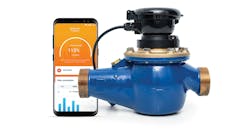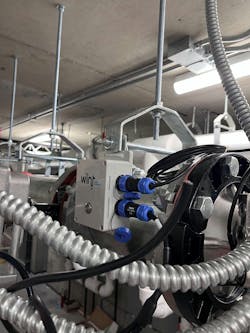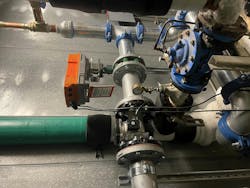NEW YORK, NY — As CONTRACTOR Magazine celebrates 70 years this September, it’s interesting to think about the evolution of technology in the trades over the decades. But, would you have ever thought that we’d be managing water through an artificial intelligence source?
Well, WINT and its experts recognized that water damage and risk were an ongoing challenge in the construction and operation of large commercial buildings and facilities. By helping stakeholders in those industries mitigate the risk of water damage and prevent water loss—by using AI—they could also help conserve a scarce, essential resource.
Since then, WINT has become the leader in AI-based water management solutions for construction and facilities. The company recently completed a $35 million Series C funding round, demonstrating the confidence investors have in WINT’s effectiveness. In addition, more than 14,000 WINT systems have been installed around the world by 400 enterprises.
Recently, we caught up with Yaron Dycian, Chief Product and Strategy Officer to learn about the water management solution.
CONTRACTOR: We are hearing more and more about AI, for better or for worse. In WINT's case, for the much better. Explain how AI is integrated into the system.
DYCIAN: WINT’s water management solution is definitely an example of artificial intelligence being applied for positive impact. AI can help organizations solve highly complex problems by applying deep analytics and continuous learning. WINT’s AI collects and analyzes data from sensors to deploy real-time solutions, mitigate risk, prioritize preventative maintenance and prevent unplanned downtime. Our technology excels in gleaning useful insights from massive amounts of data that are invisible to humans.
Our systems collect data and continuously learn and adapt to water usage patterns at each individual location. With our advanced analytics and large proprietary database, our technology can identify normal patterns of use, taking into account a building or site’s location, use, variability across hours of operation and other variables. For example, the system will recognize a continuously running toilet or heavier than anticipated use in an office building late at night. In the case of an anomaly, the system will alert management in real time and can shut off the water supply automatically to prevent large losses or potential damage.
CONTRACTOR: Is there any sort of insurance incentive to implement WINT? Explain.
DYCIAN: Water damage incidents now make up 30% of construction-related insurance claims every year, resulting in approximately $16 billion in payouts and is the third most common source of damage in commercial and residential building. As a result, the cost of premiums and deductibles for water damage claims has risen sharply, from tens of thousands of dollars a few years ago up to $1 million or more per incident in some cases.
A comprehensive risk management strategy must address the rising costs faced by contractors and insurers. Many insurers now offer financial incentives and reliefs such as lower deductibles and premiums to customers who implement WINT and other proven technology systems to manage water-related risk. Others require WINT as a prerequisite for insurance coverage.
A recently launched warranty program backed by leading international insurer HSB, a Munich Re company, protects developers and contractors from the impact of steep deductibles by providing up to $250,000 coverage for water damage on construction sites protected by WINT.
CONTRACTOR: How does WINT indirectly cut carbon emissions?
DYCIAN: The treatment and distribution of our water supply requires large expenditures of energy, which result in significant greenhouse gas emissions. Every 1,000 gallons of water consumed generates 85 pounds of carbon that is released into the atmosphere. In addition, approximately 25% of the water that enters buildings and other facilities is ultimately wasted because of leaks and inefficient water management. Reducing those inefficiencies therefore not only saves water but also cuts the carbon associated with the reduced water usage.
As a simple example, a leaking toilet continuously flows at 100-150 gallons per hour, wasting more than one million gallons a year and accounting for some 4.5 tons of greenhouse emissions—identical to the total annual emissions from a passenger car. In facilities with multiple restrooms such as office buildings, sports stadiums and shopping malls, some 2-3% of toilets typically leak at any point in time, creating significant carbon and water footprints. If a facility has on average only one leaky toilet, it has a carbon impact similar to a passenger car.
CONTRACTOR: Something like this would be ideal in a commercial building's water management plan. I'm guessing new construction is ideal but how easy/flexible is WINT in a retrofit or an add-on feature/benefit to an existing BMS?
DYCIAN: WINT is designed to operate throughout the full lifecycle of a building, from construction through operation. We provide solutions for a range of customers in a variety of industries. Installing our systems at the beginning of a construction project ensures continuity, yet they are also straightforward to install as a retrofit through a simple installation of a valve and meter, which can be done by most plumbers.
Moreover, WINT solutions are designed to work with the leading building management systems. It provides an open API and has custom integration with leading BMS platforms such as Schneider Electric.
CONTRACTOR: Explain machine learning processes—pattern learning and use optimization—as it relates to the WINT water management solution.
DYCIAN: WINT’s solutions are based on artificial intelligence, machine learning and pattern recognition technology. Strategically placed sensors work with machine learning capabilities and advanced analytics to learn the usual consumption patterns at each individual site. The technology recognizes normal usage patterns and sends real-time alerts if any unusual or abnormal patterns are detected.
WINT’s AI algorithms for a variety of use cases—industry, construction, residential—continuously adapt to usage patterns for water networks as well as for specific devices. For example, WINT can prevent water damage by detecting the high flow of water that results from a broken pipe, issuing an alert, identifying the precise location of the leak and automatically shutting off the water supply. WINT systems can also quickly identify the additional flow that results from a stuck toilet and send an alert within minutes so management teams can immediately address the situation.
CONTRACTOR: WINT saved more than 652 million gallons of water and prevented 900 incidents last year through 400 global companies. Those are some impressive numbers. Obviously, you can't project the water savings, but what is the goal in terms of WINT installs by the end of 2024?
DYCIAN: We’ll continue to help organizations solve critical challenges in 2024 and beyond. Water damage in buildings and construction sites has a very real impact on multiple industries, and rising costs for insurance add to the urgency of the situation. We expect next year’s savings to be somewhere between 1 to 1.5 billion gallons.
While we’re proud of our accomplishments, our success also demonstrates the serious need for lasting, reliable solutions to the world’s water issues.





